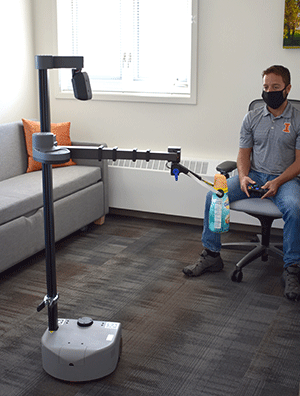
Is There a Robot in Your Future?
AHS E-News September 2021

Dr. Wendy Rogers, Khan Professor of Applied Health Sciences in the Department of Kinesiology and Community Health, has long believed that technology can help people who are aging and those with disabilities to maintain their independence and enjoy a high quality of life. A world-renowned scholar in the area of human factors and aging, she was honored this year as the 2021 King McCristal Distinguished Scholar in the College of Applied Health Sciences. She delivered the McCristal Lecture during the AHS Fall College Meeting on August 17.
Dr. Rogers’ research has investigated such issues as using technology to reduce isolation and enhance social engagement among older adults, healthcare technology acceptance, mobile health applications, and the role of technology in aging in place. Another area of interest is robotics, and this was the focus of her remarks.
“I chose this focus because robots are fun and interesting and have so much potential to help individuals as we age or individuals with disabilities or individuals who need some kind of support,” she said. Her own work with robots began in 2010 at the Georgia Institute of Technology, where she was a professor in the School of Psychology and a principal investigator in the NIH-funded Center for Research and Education on Aging and Technology Enhancement. She and colleague Dr. Charlie Kemp, director of the Healthcare Robotics Lab at Georgia Tech and co-founder of Hello Robot, took charge of a personal robot manufactured by Willow Garage called PR-2.
“PR-2 was specifically made for research,” Dr. Rogers said. “We were chosen to receive one because we were the only research group that was really thinking about human-robot interaction and we were the only group focused on older adults.”
In designing robots for older adults, a number of issues must be considered, she continued. Are older adults willing to use a robot? What are their attitudes and preferences? Do they have concerns about trust or safety?
 At 500 pounds, PR-2 was big and loud and, at $400,000, expensive. “But the older adults loved it and could really see the potential for this kind of technology,” Dr. Rogers said. A short decade or so later, Dr. Rogers and her University of Illinois research colleagues took delivery of a new research robot called Stretch. Developed by Dr. Kemp and Hello Robot co-founder Aaron Edsinger, former robotics director at Google, Stretch weighs about 50 pounds and costs less than $18,000. The robot resides at the McKechnie Family LIFE Home, which Dr. Rogers directs, where researchers are assessing how Stretch can support tasks around the home, investigating facilitators and barriers to usage, comparing different ways of controlling the robot, and determining the level of instructional support necessary to make it user friendly.
At 500 pounds, PR-2 was big and loud and, at $400,000, expensive. “But the older adults loved it and could really see the potential for this kind of technology,” Dr. Rogers said. A short decade or so later, Dr. Rogers and her University of Illinois research colleagues took delivery of a new research robot called Stretch. Developed by Dr. Kemp and Hello Robot co-founder Aaron Edsinger, former robotics director at Google, Stretch weighs about 50 pounds and costs less than $18,000. The robot resides at the McKechnie Family LIFE Home, which Dr. Rogers directs, where researchers are assessing how Stretch can support tasks around the home, investigating facilitators and barriers to usage, comparing different ways of controlling the robot, and determining the level of instructional support necessary to make it user friendly.
Stretch also is being put through its paces in the field, thanks to a collaboration among the LIFE Home team, V Nguyen, an occupational therapy student at Pacific University in Oregon, and Henry Evans, who has severe quadriplegia. For her doctoral capstone project, V has been investigating how Stretch can help Henry gain more independence at home. Equipping Stretch with tools designed by V has enabled Henry to feed himself, scratch his head, and give his wife and primary caregiver Jane a rose, among numerous other tasks.
“These seem like small things, but they are big things,” Dr. Rogers said. “There’s huge potential for impact here.”
Henry has experienced in his own life the large impact that robotics can have, and said, ”Stretch is an important link in the evolution of those robots.” Henry’s wife Jane added, “We have to ask ourselves over and over: why use robots when a caregiver can do it 10 times faster?” she said. “I see what it does to my husband mentally, when he can do things by himself and not depend on anyone.”
In a new course offered this semester called Human-Robot Interaction in Community Health, Dr. Rogers is focusing on how robots can be used to improve health and well-being in populations with diverse needs and abilities. Other robot-related research in which she is involved includes an effort to develop mobile robots to assist with wayfinding and navigation tasks for people with vision disabilities, an investigation of soft and dexterous robots to support healthcare at home for older adults, and an assessment of domestic robot acceptance among older adults.
